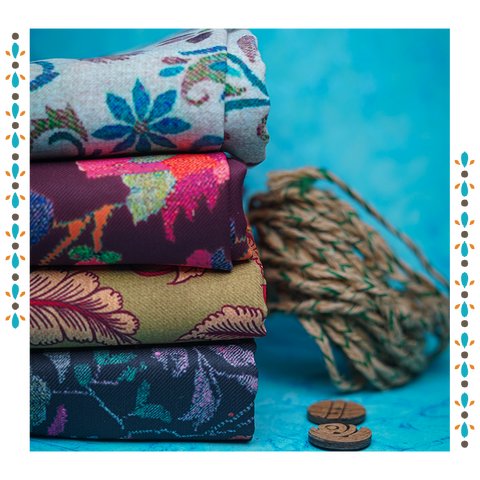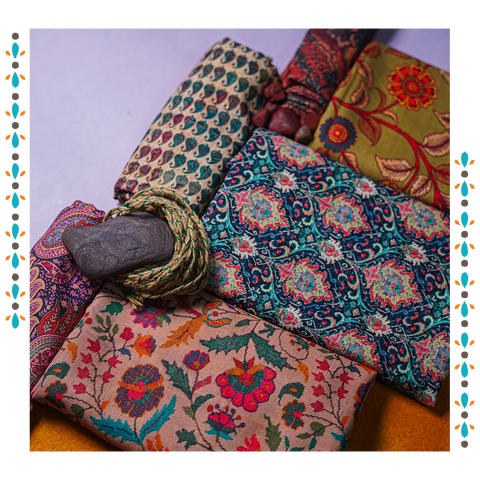Pashmina: Rooted in Upholding the Royalty & Warmth
The luxurious and finest Pashmina fabric’s iconic story had begun over 500 years ago in Kashmir valley, India. Where local Kashmiri skilled artisans have worked with this luscious fabric by hand for centuries to create exquisite pashmina shawls and more elaborate hand-woven crafted pieces from this luxurious fabric.
However, Pashmina fabric represents the true heritage of elegance and richness. It has always been one of the most beloved and desired fabrics by all women around the globe.
However, it’s not yet clear what exactly Pashmina is. Do you know the origin of this finest textile fabric? To learn more about this timeless artistry let's dive in.
What does the word ‘Pashmina’ mean?
The Pashmina word is derived from the Persian word ‘Pashm’, which means ‘soft gold’. Traditionally in Kashmir, pashmina is the art of creating beautiful shawls, stoles, or wearable accessories from soft cashmere wool.
What exactly is ‘Pashmina’?
A Pashmina is an art of handcrafted luxury textile made from the soft underfur of a Changthangi or a Pashmina goat that lives in the Changthang area of Ladakh, India.
Changthangi and Pashmina goats are a special breed of goats that are native to the high-altitude regions of Nepal and India. This finest material is used to make the well-known Pashmina shawls. The Pashmina silk fabrics are made from the softest animal fibers used in the textile industry. It is delicate and warm enough to hatch an egg. In Kashmir, the art of weaving pashmina has been passed down from generation to generation. For a good pashmina shawl spinning, weaving and embroidery need to be done by an expert.

Origin of this finest textile?
It all began with Mir Syed Ali Hamdani, a Persian saint who went on a world tour. With 700 artists, Mir Syed Ali Hamdani transformed Kashmir's natural beauty and spread the gospel in the Middle East. While he was in Changthang-Ladakh, he took a break to put up his feet, and as a result, the saint appeared on Changthangi Mountain. As he looked out to the beautiful landscape, he was awed by the goat’s stunning fleece. He then spun the wool into socks for the Sultan Zain-ul-Abideen, who was amazed by the quality of the fabric. Seeing the potential of pashmina wool cultivation, he advocated establishing a business around it: "Pashm," from which the name "Pashmina" is derived, means "soft gold."
Cashmere and Pashmina: What’s the difference?
A Cashmere shawl has been made in Kashmir and Nepal for thousands of years. Pashmina and Cashmere shawls are both woven from mountain sheep’s wool. It is mainly the diameter of the fiber that differentiates them. A cashmere fiber has a large diameter and is thicker than a pashmina, which is finer, thinner, and far more delicate. For this reason, local Kashmiri artisans comb, refine, spin, weave and embroider pashmina fabric completely by hand.
The Intricate Making and the Process of the World’s Finest Fiber - Pashmina

The intricate process of producing pashmina begins when Changthangi goats naturally shed their winter coats every spring, this period locally known as the molting season. This is when the undercoat is gathered by combing the goat instead of shearing, which is the method used to collect other fine wools. In the following step, then raw pashmina is then exported to Kashmir.
After it arrives, highly-specialized designers, artisans, and craftspeople use traditional techniques passed down from generation to generation since the 15th century to refine and transform it into a fabric by hand. After the fabric is made, Kashmiri artists utilize it to make luxurious, unique, and very artistic pashmina scarves, robes, shawls, blankets, apparel, and other items.
A guide to maintaining Pashmina fabrics
Taking proper care of cashmere products can extend the life of the garments. The more often they are washed, the softer and more luxurious they become. It is recommended that this fabric should preferably be dry-cleaned. However, a woollen fabric detergent can be used occasionally to gently hand wash it. Hand washing a new Pashmina is advised to guarantee that the natural vegetable colors do not bleed. Allow it to dry on a level surface after washing.
So, next time you visit Kashmir, get this luxurious heritage weave, ‘Pashmina’, as a souvenir.
Shop the wide range of poly based Pashmina Fabrics from Symplico Prints, by selecting the designs from 2000+ artistic prints and get them imprinted on the Pashmina fabric.
Stay tuned for more useful updates...
Read About: A Style Guide On Different Scarf Fabrics







